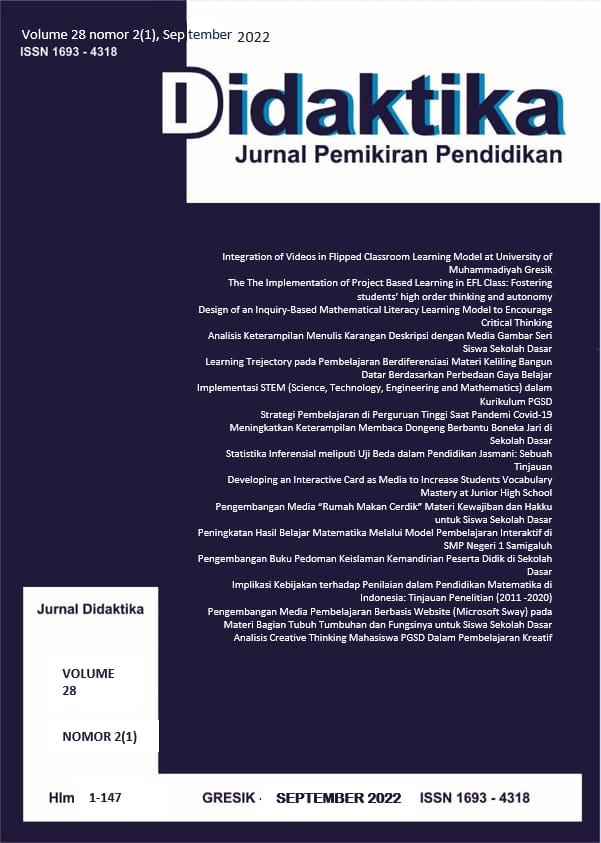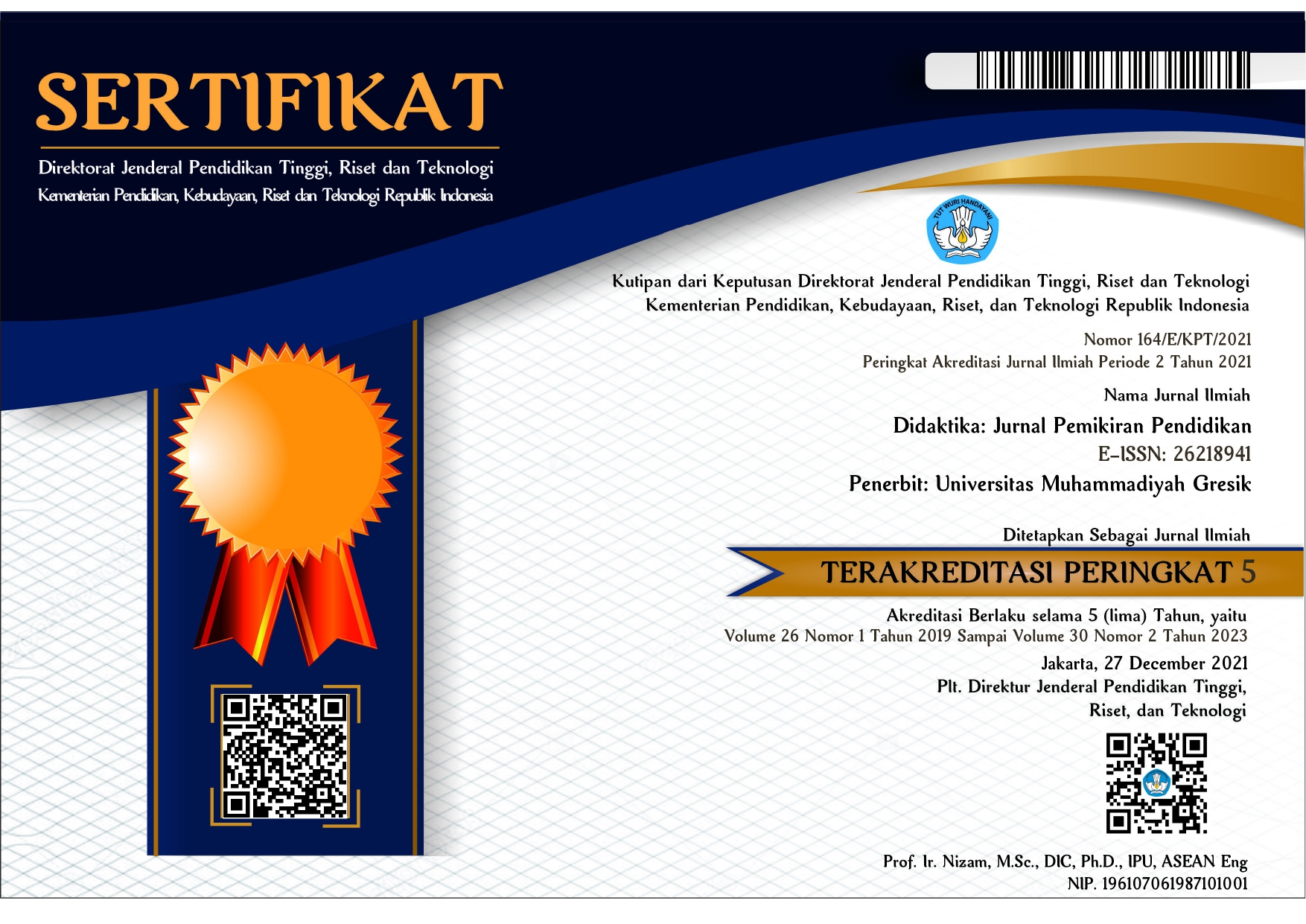Integration of Videos in Flipped Classroom Learning Model at University of Muhammadiyah Gresik
DOI:
https://doi.org/10.30587/didaktika.v28i2.4137Keywords:
learning model, flipped classroom, new normal education, students' perceptionAbstract
The COVID-19 pandemic has given the effect of changing learning models and requiring teachers to improve their skills in implementing online learning especially in university level. At University of Muhammadiyah Gresik, various learning models were applied by lecturers, one of which was the flipped classroom learning model. Flipped classroom is a learning model in which students are required to study the material first at home or outside the classroom within a few days before the learning process begins. Flipped classroom can make it easier for students to understand the learning material because students have more time study with the explanation videos given. A qualitative approach was used in this study to find out the students’ perception to the implementation of flipped classroom in the learning process. The result of this study found that the implementation of flipped classroom was well received by the students. Students responded that flipped classroom helped them understand the material easier, provided more interactive activities in the classroom, and guided them to improve their learning abilities independently. Thus, flipped classroom was also considered as an innovative learning model that can be implemented the learning process in new normal education.
References
Aljaraideh, Y. 2019. Students’ Perception of Flipped Classroom: A Case Study for Private Universities in Jordan. JOTSE, Journal of Technology and Science Education. 9(3): 368-377.
Awidi, I. T., & Paynter, M. 2019. The impact of a flipped classroom approach on student learning experience. Computers & Education, 128, 269-283.
Chandra, F. H. & Nugroho, Y. W. 2016. Peran teknologi video dalam flipped classroom. Dinamika Teknologi. 8 (1): 15 – 20.
Du, X., Zhang, M., Shelton, B. E., & Hung, J. L. 2019. Learning anytime, anywhere: a spatio temporal analysis for online learning. Interactive Learning Environments, 1-15.
Farida, R., Alba, A., Kurniawan, R., & Zainuddin, Z. 2019. Pengembangan Model Pembelajaran Flipped Classroom Dengan Taksonomi Bloom Pada Mata Kuliah Sistem Politik Indonesia. Kwangsan: Jurnal Teknologi Pendidikan. 7. 104. 10.31800/jtp.kw. v7n2.p104--122.
Johnson, G. B. 2013. Student Perceptions of The Flipped Classroom, Columbia: The University of British Columbia.
Keputusan Bersama Menteri Pendidikan dan Kebudayaan No. 01/KB/2020, Menteri Agama No. 516 Tahun 2020, Menteri Kesehatan No. HK.03.01/Menkes/363/2020, dan M. D. N. N. 440-882 T. 2020. (2020). Panduan Penyelenggaraan Pembelajaran pada Tahun Ajaran 2020/2021 dan Tahun Akademik 2020/2021 di Masa Pandemi Corona Virus Disease 2019 (Covid-19).
Lee, Y. M., Mann, K, V., & Frank, B. W. 2010. What Drives Students Self-Directed Learning in a Hybrid PBL Curriculum. Adv in Health SciEdu. 2010:15.
Oishi, I, R, V. 2020. Pentingnya Belajar Mandiri bagi Peserta Didik di Perguruan Tinggi. Jurnal IKRA-ITH Humaniora, Vol 4, No 2.
Shyr, W. J., & Chen, C. H. 2018. Designing a technology‐enhanced flipped learning system to facilitate students' self‐regulation and performance. Journal of Computer assisted learning, 34(1), 53-62.
Sukawati, S. 2021. Pentingnya Inovasi Pembelajaran di Era Pandemi. IKIP Siliwangi Bandung.
Syah, M. 2007. Psikologi Belajar. Jakarta: PT. Raja Grafindo Persada.
Syam, A. 2014. The Flipped Class: Shedding Light on the Confusion, Critique, and Hype. The Daily Riff. 7 April 2015.
Downloads
Published
How to Cite
Issue
Section
License
License and Copyright Agreement
In submitting the manuscript to the journal, the authors certify that:
- They are authorized by their co-authors to enter into these arrangements.
- The work described has not been formally published before, except in the form of an abstract or as part of a published lecture, review, thesis, or overlay journal.
- That it is not under consideration for publication elsewhere,
- That its publication has been approved by all the author(s) and by the responsible authorities – tacitly or explicitly – of the institutes where the work has been carried out.
- They secure the right to reproduce any material that has already been published or copyrighted elsewhere.
- They agree to the following license and copyright agreement.
Copyright
Authors who publish with DIDAKTIKA: Jurnal Pemikiran Pendidikan agree to the following terms:
- Authors retain copyright and grant the journal right of first publication with the work simultaneously licensed under a Creative Commons Attribution License (CC BY-SA 4.0) that allows others to share the work with an acknowledgment of the work's authorship and initial publication in this journal.
- Authors are able to enter into separate, additional contractual arrangements for the non-exclusive distribution of the journal's published version of the work (e.g., post it to an institutional repository or publish it in a book), with an acknowledgment of its initial publication in this journal.
- Authors are permitted and encouraged to post their work online (e.g., in institutional repositories or on their website) prior to and during the submission process, as it can lead to productive exchanges, as well as earlier and greater citation of published work.
Licensing for Data Publication
Open Data and Software Publishing and Sharing
The journal strives to maximize the replicability of the research published in it. Authors are thus required to share all data, code or protocols underlying the research reported in their articles. Exceptions are permitted but have to be justified in a written public statement accompanying the article.
Datasets and software should be deposited and permanently archived inappropriate, trusted, general, or domain-specific repositories (please consult http://service.re3data.org and/or software repositories such as GitHub, GitLab, Bioinformatics.org, or equivalent). The associated persistent identifiers (e.g. DOI, or others) of the dataset(s) must be included in the data or software resources section of the article. Reference(s) to datasets and software should also be included in the reference list of the article with DOIs (where available). Where no domain-specific data repository exists, authors should deposit their datasets in a general repository such as ZENODO, Dryad, Dataverse, or others.
Small data may also be published as data files or packages supplementary to a research article, however, the authors should prefer in all cases a deposition in data repositories.











